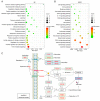The Main Alkaloids in Uncaria rhynchophylla and Their Anti-Alzheimer's Disease Mechanism Determined by a Network Pharmacology Approach
- PMID: 33807157
- PMCID: PMC8036964
- DOI: 10.3390/ijms22073612
The Main Alkaloids in Uncaria rhynchophylla and Their Anti-Alzheimer's Disease Mechanism Determined by a Network Pharmacology Approach
Abstract
Alzheimer's disease (AD) is a growing concern in modern society, and effective drugs for its treatment are lacking. Uncaria rhynchophylla (UR) and its main alkaloids have been studied to treat neurodegenerative diseases such as AD. This study aimed to uncover the key components and mechanism of the anti-AD effect of UR alkaloids through a network pharmacology approach. The analysis identified 10 alkaloids from UR based on HPLC that corresponded to 90 anti-AD targets. A potential alkaloid target-AD target network indicated that corynoxine, corynantheine, isorhynchophylline, dihydrocorynatheine, and isocorynoxeine are likely to become key components for AD treatment. KEGG pathway enrichment analysis revealed the Alzheimers disease (hsa05010) was the pathway most significantly enriched in alkaloids against AD. Further analysis revealed that 28 out of 90 targets were significantly correlated with Aβ and tau pathology. These targets were validated using a Gene Expression Omnibus (GEO) dataset. Molecular docking studies were carried out to verify the binding of corynoxine and corynantheine to core targets related to Aβ and tau pathology. In addition, the cholinergic synapse (hsa04725) and dopaminergic synapse (hsa04728) pathways were significantly enriched. Our findings indicate that UR alkaloids directly exert an AD treatment effect by acting on multiple pathological processes in AD.
Keywords: AD pathology; Alzheimer’s disease; Uncaria rhynchophylla; alkaloids; network pharmacology.
Conflict of interest statement
The authors declare that there are no conflicts of interest. The funders had no role in the design of the study; in the collection, analyses, or interpretation of data; in the writing of the manuscript; or in the decision to publish the results.
Figures









References
-
- McKhann G., Drachman D., Folstein M., Katzman R., Price D., Stadlan E.M. Clinical diagnosis of Alzheimer’s disease: Report of the NINCDS-ADRDA Work Group under the auspices of Department of Health and Human Services Task Force on Alzheimer’s Disease. Neurology. 1984;34:939–944. doi: 10.1212/WNL.34.7.939. - DOI - PubMed
MeSH terms
Substances
Grants and funding
LinkOut - more resources
Full Text Sources
Other Literature Sources
Medical

